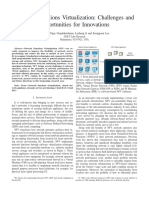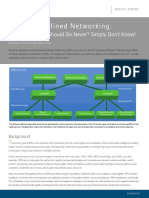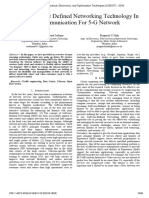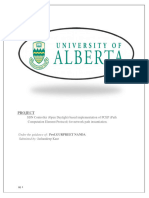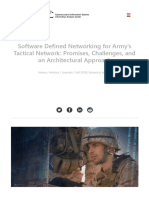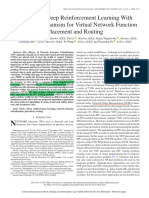Software-Defined Network Virtualization: An Architectural Framework For Integrating SDN and NFV For Service Provisioning in Future Networks
Software-Defined Network Virtualization: An Architectural Framework For Integrating SDN and NFV For Service Provisioning in Future Networks
Uploaded by
nwaraCopyright:
Available Formats
Software-Defined Network Virtualization: An Architectural Framework For Integrating SDN and NFV For Service Provisioning in Future Networks
Software-Defined Network Virtualization: An Architectural Framework For Integrating SDN and NFV For Service Provisioning in Future Networks
Uploaded by
nwaraOriginal Title
Copyright
Available Formats
Share this document
Did you find this document useful?
Is this content inappropriate?
Copyright:
Available Formats
Software-Defined Network Virtualization: An Architectural Framework For Integrating SDN and NFV For Service Provisioning in Future Networks
Software-Defined Network Virtualization: An Architectural Framework For Integrating SDN and NFV For Service Provisioning in Future Networks
Uploaded by
nwaraCopyright:
Available Formats
Software-Defined Network Virtualization:
An Architectural Framework for
Integrating SDN and NFV for
Service Provisioning in Future Networks
Qiang Duan, Nirwan Ansari, and Mehmet Toy
Abstract
SDN and NFV are two significant innovations in networking. The evolution of both
SDN and NFV has shown strong synergy between these two paradigms. Recent
research efforts have been made toward combining SDN and NFV to fully exploit
the advantages of both technologies. However, integrating SDN and NFV is chal-
lenging due to the variety of intertwined network elements involved and the com-
plex interaction among them. In this article, we attempt to tackle this challenging
problem by presenting an architectural framework called SDNV. This framework
offers a clear holistic vision of integrating key principles of both SDN and NFV
into unified network architecture, and provides guidelines for synthesizing research
efforts toward combining SDN and NFV in future networks. Based on this frame-
work, we also discuss key technical challenges to realizing SDN-NFV integration
and identify some important topics for future research, with a hope to arouse the
research community’s interest in this emerging area.
R apid advancement in networking and computing tech-
nologies has enabled a wide variety of applications
with diverse requirements on network services. The highly
diverse and dynamic network services demanded by current
a network architecture concept that leverages virtualization
technologies to transfer network functions from hardware
appliances to software applications [3]. Essentially, NFV
embraces the notion of network virtualization and provides
and emerging applications bring in new challenges to service more specific mechanisms to decouple service functions from
provisioning in future networks. Software-defined networking infrastructures. Benefits introduced by NFV include simpli-
(SDN) and network functions virtualization (NFV) are two fied service development, more flexible service delivery, and
significant recent innovations that are expected to address reduced network capital and operational costs.
these challenges. Although SDN and NFV were initially developed as inde-
SDN separates network control and data forwarding func- pendent networking paradigms, the evolution of both tech-
tionalities to enable centralized and programmable network nologies has shown strong synergy between them. SDN and
control [1]. Key components of the SDN architecture include NFV share common goals and similar technical ideas, and
a data plane consisting of network resources for data forward- are complementary to each other. Integrating SDN and NFV
ing, a control plane comprising SDN controller(s) providing in future networking may trigger innovative network designs
centralized control of network resources, and control/manage- that fully exploit the advantages of both paradigms. Recently,
ment applications that program network operations through a combining SDN and NFV has started attracting attention from
controller. The control-resource interface between the control both academia and industry. However, integrating SDN and
and data planes is called the southbound interface, while the NFV is challenging due to the variety of intertwined network
control-application interface is called the northbound inter- elements involved and the complex interaction among them.
face. Advantages promised by SDN include simplified and Currently, SDN and NFV are still being studied and standard-
enhanced network control, flexible and efficient network man- ized without sufficient synergy. Therefore, there is an urgent
agement, and improved network service performance. need for a holistic architectural framework in which SDN and
Network virtualization introduces an abstraction of the NFV principles may be combined naturally.
underlying infrastructure upon which virtual networks with In this article, we attempt to tackle the challenging problem
alternative architecture may be constructed to meet diverse of integrating SDN and NFV by proposing an architectur-
service requirements [2]. More recently, the European Tele- al framework called software-defined network virtualization
communications Standards Institute (ETSI) developed NFV, (SDNV). The SDNV framework combines the SDN principle
of separating data and control planes with the NFV princi-
Qiang Duan is with Pennsylvania State University. ple of decoupling service functions from infrastructures, thus
Nirwan Ansari is with New Jersey Institute of Technology.
providing a clear holistic vision of SDN and NFV integration.
Specifically, we first discuss how SDN and NFV may benefit
Mehmet Toy is with Comcast Cable Communications. from each other, and present a two-dimensional abstraction
10 0890-8044/16/$25.00 © 2016 IEEE IEEE Network • September/October 2016
Management plane
Plane-dimension
abstraction Control plane
model to show the relationship between SDN and NFV princi-
ples. Then we propose the SDNV framework architecture that Data plane
provides a high-level picture of integrating SDN and NFV.
Following this framework, we discuss key technical challenges Application layer
to realizing SDN-NFV integration and identify some import-
ant topics in this area for future research. Transport layer
Integrating SDN and NFV for Service Layer-dimension
abstraction
Internet layer
Provisioning in Future Networks Network interface layer
The past few years have witnessed exciting progress in SDN
technologies and their applications in various networking Physical layer
scenarios [1], including wireless networks [4]. On the other
hand, researchers have noticed some issues of the current
SDN approach that may limit its ability to fully support future Figure 1. A two-dimensional model of layer-plane abstraction
network services [5, 6]. To meet the evolving diverse service in future networking.
requirements, SDN data plane devices need to fully perform
general flow matching and packet forwarding, which may sig-
nificantly increase complexity and cost of SDN switches. On working on a draft report regarding SDN usage in the NFV
the control plane, current SDN architecture lacks sufficient architecture [13].
support of interoperability among heterogeneous SDN con- Although encouraging progress has been made toward
trollers, and thus limits its ability to provision flexible end-to- combining SDN and NFV, research in this area is still in its
end services across autonomous domains. infant stage. Current works address the problem from vari-
A root reason for the limitation of current SDN design to ous aspects, including hypervisors for virtual SDN networks,
achieve its full potential for service provisioning is the tight usage of SDN controllers in NFV architecture, and SDN/NFV
coupling between network architecture and infrastructure on hybrid solutions for service provisioning. It is desirable to have
both data and control planes. Separation between data and a high-level framework that provides a holistic vision about
control planes alone in the current SDN architecture is not how SDN and NFV principles may naturally fit into unified
sufficient to overcome this obstacle. Another dimension of network architecture, which may greatly facilitate the research
abstraction to decouple service functions and network infra- and technical development in this area. This motivates the
structures is needed in order to unlock SDN’s full potential. work presented in the rest of this article.
Therefore, applying the insights of NFV in SDN may further
enhance the latter’s capability of flexible service provisioning. A Two-Dimensional Abstraction Model for
On the other hand, many technical challenges must be
addressed for realizing the NFV paradigm. Management and SDN and NFV Integration
orchestration have been identified as key components in the In this section, we present a two-dimensional abstraction
ETSI NFV architecture. Much more sophisticated control model to show how SDN and NFV principles are related to
and management mechanisms for both virtual and physical each other and how they may fit in unified network architec-
resources are required by the highly dynamic networking envi- ture.
ronment enabled by NFV, in which programmatic network As shown in Fig. 1, this abstraction model has layers as well
control is indispensable. Employing the SDN principle — as planes with clear distinction between these two concepts.
decoupling control intelligence from the controlled resources Both layers and planes offer abstraction in network archi-
to enable a logically centralized programmable control/man- tecture but in different dimensions. Abstraction provided by
agement plane — in the NFV architecture may greatly facili- layers is in the vertical dimension in the model, starting with
tate realization of NFV. underlying hardware and then adding a sequence of layers,
Recent research efforts toward combining SDN and NFV each providing a higher (more abstract) level of service. A key
to enhance network service provisioning have been made from property of layering is that the functions of a higher layer rely
various aspects. Hypervisor and container-based virtualization on the services provided by the lower layers, therefore forming
mechanisms have been applied to support multi-tenant virtual a stack of layers for offering services to applications on the
SDN networks. For example, the network hypervisor Flow- top. On the other hand, plane abstraction is in the horizon-
Visor [7] allows multiple controllers to share an OpenFlow tal dimension in that functions performed on a plane do not
platform and slice data plane infrastructure. FlowN [8] offers necessarily rely on functions of another plane; therefore, there
a container-based virtualization solution in which each tenant is no higher or lower plane. Instead, each plane focuses on a
may run its own control application on a shared SDN con- particular aspect of the entire network system, such as data
troller. Some network system designs have explored utilizing transport, network control, and system management. Each
capabilities of both SDN and NFV. For example, Woods et plane may comprise multiple layers from physical hardware
al. [9] presented NetVM, a high-performance virtual server to application software, and collaborates with other planes for
platform for supporting NFV, and discussed design guidelines network service provisioning.
for combining SDN controllers with NetVM to provide coordi- Traditional circuit-switching-based telecommunication sys-
nated network management. Ding et al. [10] designed an open tems embraced plane-dimension abstraction (separating data,
platform for service chain as a service by using capabilities control, and management planes) without clear abstraction
of SDN together with NFV. The progressive evolution from on the layer dimension. For example, Signal System No. 7 was
SDN-agnostic NFV initiative to SDN-enabled NFV solution logically separated from voice channels, and the intelligent
was discussed in [11]. Relevant standardization organizations network (IN) had service control points (SCPs) decoupled
are also actively conducting related study. The Open Network from the data transportation platform.
Foundation (ONF) recently released a report on the relation- The IP-based Internet architecture shows clear layer-di-
ship of SDN and NFV [12], and ETSI NFV ISG is currently mension abstraction but lacks explicitly defined abstraction in
IEEE Network • September/October 2016 11
Virtual Service-oriented Decoupling
service functions control/management service mous domains. The virtualization layer realizes abstraction
functions
of physical infrastructures into virtual resources and provides
Physical Infrastructure and
infrastructure mapping between physical and virtual resources. The service
infrastructure control/management
layer is responsible for providing service-related functional-
resources
ities. This layer utilizes the virtual resources made available
by the virtualization layer to realize virtual service functions
Separating data plane and control plane (VSFs), including both virtual network functions (VNFs) and
virtual compute functions (VCFs). The service layer selects
Figure 2. Integrating key principles of SDN and NFV in and orchestrates appropriate VSFs to construct virtual net-
unified network architecture. works (VNs) for meeting service requirements of user appli-
cations.
Both infrastructure and service layers of the SDNV frame-
the plane-dimension. Packet forwarding, routing, and network work have separated data and control/management planes.
management functions are mixed in the same set of IP proto- The control/management plane on the infrastructure layer
cols. Wide adoption of IP-based architecture has made the lay- consists of controllers for network and compute infrastruc-
er-dimension abstraction dominant in current network designs. tures. Heterogeneous SDN controllers and southbound proto-
Rapid development of the wide spectrum of Internet services cols (e.g., OpenFlow and ForCES) may be applied in different
requires much more flexible network control and management, domains. We refer to such controllers as infrastructure domain
which is limited by the tight coupling between control/manage- controllers (IDCs). The control/management plane on the
ment and data forwarding in the current Internet architecture. service layer is responsible for VSF and VN life cycle manage-
SDN essentially brings in the plane-dimension abstraction by ment, including construction, instantiation, maintenance, and
separating the data and control/management planes. Although termination of VSFs/VNs. VNs are constructed by composing
the TCP/IP stack provides layer-dimension abstraction, the appropriate VSFs for meeting service requirements. Each VN
interfaces between layers are not defined flexibly enough to has its own controller (called VNC) that controls all the data
meet the requirement of future network services. A key obstacle plane VSFs involved in this VN, just like an SDN controller
lies in the unnecessary coupling between service-oriented func- controls all switches in a physical network domain. The vir-
tions and transport-oriented infrastructures that limits network tualization layer decouples service-oriented control/manage-
design from fully exploiting the benefits of layer-dimension ment from infrastructure domain control, while providing a
abstraction. The network virtualization notion advocates decou- standard interface through which service control/management
pling service provisioning from network infrastructure, and the functions may interact with infrastructure controllers. Such
NFV architecture attempts to leverage standard IT technologies decoupling on the control/management plane enables differen-
to realize such decoupling through simple but flexible abstrac- tiation between control/management functions associated with
tion of underlying hardware infrastructures. transport infrastructures and those related to services, and
It is worth mentioning that the TCP/IP layer stack is used thus allows them to be provided, maintained, and developed
in Fig. 1 just as an example to show the concept of layer-di- independently following their own evolutionary paths.
mension abstraction. The model is applicable to network
architecture with alternative layers. The vertical decoupling Key Interfaces of the SDNV Framework
highlighted between the network interface and Internet layers The interface provided by the virtualization layer enables
in the figure is also for illustration. In fact, position of virtu- high-level abstraction of underlying network and compute
alization in the layer dimension is a design option for virtu- infrastructures, including both data plane capabilities and con-
alization-based network architecture. Similarly, control and trol/management functionalities. This interface decouples the
management can be considered as either one plane or two logical topologies, addressing schemes, and routing mech-
separated planes in the plane dimension. anisms of VNs from those of physical infrastructures while
From the layer-plane abstraction model, we can see that the maintaining the mapping between virtual and physical objects.
key principles of both SDN and NFV are based on abstrac- In addition, the virtualization layer interface should guarantee
tion but with emphasis on the plane and layer dimensions, isolation between virtual objects to allow multi-tenant VNs to
respectively. These two abstraction dimensions are orthog- share a common infrastructure substrate.
onal; that is, network architecture may have abstraction on Another important interface is between the data plane
one dimension but not on the other. Therefore, SDN and and the control/management plane. This interface decouples
NFV in principle are independent — NFV may be realized control/management functionalities from physical infrastruc-
with or without SDN and vice versa. On the other hand, the ture resources and VNFs, thus realizing the plane-dimension
challenging requirements for service provisioning in future abstraction in the SDNV framework. Since this interface is
networks demand abstraction on both dimensions in order between controllers and controlled resources/functions, it is
to fully exploit their advantages. Therefore, integrating the referred to as the southbound (SB) interface following SDN
software-defined principle and the virtualization notion leads terminology. Clear separation between the service layer and
to unified network architecture with key components in four infrastructure layer in SDNV requires the SB interface to be
quadrants and abstract interfaces for loose coupling between split to two sub-interfaces. The SB interface on the infrastruc-
them, as shown in Fig. 2. ture layer provides interactions between IDCs and the physical
network/compute devices under their control, and is therefore
called the physical SB (P-SB) interface. The SB interface on
Software-Defined Network Virtualization for the service layer allows each VNC to control the data plane
Integrating SDN and NFV VSFs in its VN following the centralized control principle of
SDN, and is therefore called the virtual SB (V-SB) interface.
Key Components of the SDNV Framework SDNV allows multiple independent P-SB interfaces for meet-
The SDNV framework is shown in Fig. 3. The infrastructure ing requirements of different domains coexisting in the infra-
layer comprises the physical resources of network and com- structure layer. Similarly, VNs customized for various services
pute infrastructures, which may consist of multiple autono- may adopt different V-SB interface protocols.
12 IEEE Network • September/October 2016
User User User
application application application
The interface between user applica- Service access Service configuration
tions and service control/management
allows applications to program VNs. It Service layer Virtual NB interface
plays a similar role as the northbound
Virtual Virtual Virtual VNC-m
(NB) interface in the SDN architecture network-1 network-m SB Interface
VSF/VN
but for VNs, and therefore is called management
/orchestration
the virtual NB interface. This inter- VNC-1
face offers service abstraction through VSF VSF VSF VSF
which user applications may access and
configure network services via standard Virtualization layer
application programming interfaces
(APIs). This interface should support Infrastructure Physical Infrastructure
isolation among APIs for different domain-n SB Interface controller-n
VNCs in order to provide independent
programmability for individual VNs. Infrastructure Infrastructure
domain-1 controller-1
Infrastructure layer
Key Features of the SDNV
Data plane Control/management plane
Framework
The SDNV framework combines the Figure 3. Software-defined network virtualization architectural framework.
notion of network virtualization —
decoupling service functions from
underlying infrastructures — with the core principle of SDN current SDN and NFV architecture but to provide an archi-
— separating data and control/management planes — and can tectural framework showing how these two paradigms may be
thus fully exploit the advantages of both paradigms. The lay- integrated together for future networking. On the other hand,
er-dimension abstraction introduced by the virtualization layer SDNV is not to simply put current architecture of SDN and
allows life cycles of VSFs and VNs to be independent of those NFV together but to combine the key insights of both para-
of physical infrastructures, thus enabling rapid innovations digms into unified network architecture and show how SDN
both above and below the virtualization layer. The plane-di- and NFV may cooperate inside such architecture. This frame-
mension abstraction in the SDNV framework separates data work provides useful guidelines to synthesize research from
forwarding and control/management functions on both the various aspects toward the common objective of integrating
infrastructure and service layers. Such abstraction on the infra- SDN and NFV for supporting service provisioning in future
structure layer supports logically centralized programmable networks.
control for each infrastructure domain. Similarly, decoupling
data and control planes on the service layer allows each VN to A Use Case of the SDNV Framework
have a central programmable VNC that controls all the data In this subsection, we present a use case example of the SDNV
plane VSFs involved in this VN for service provisioning. framework to illustrate how the framework may guide future
The SDNV framework naturally supports multi-provid- network design.
er service scenarios in which diverse VNs are created on End-to-end service provisioning across heterogeneous net-
a physical substrate consisting of heterogeneous network work domains is challenging in current SDN architecture.
and compute infrastructures in multiple domains. There- The centralized control of a single SDN controller is limited
fore, SDNV embraces the trend of unified network-cloud by its network domain boundary, and interoperation between
service provisioning. VSFs in SDNV may provide service heterogeneous SDN controllers in different domains is still
functions virtuaized from networking systems (VNFs) as an open issue. Following the SDNV framework, functions for
well as from cloud resources (VCFs). End-to-end services service provisioning in the SDN architecture may be decou-
delivered by VNs through orchestrating VNFs and VCFs pled from infrastructure domains by a virtualization layer,
are essentially composite network-cloud services. Such a thus enabling a service delivery platform as shown in Fig.
converged service ecosystem may introduce new functional 4. In this platform, the infrastructure resources and control
roles, such as suppliers of VSFs and providers of compos- functionalities in each domain are virtualized as VNFs and
ite network-cloud services, and trigger innovations of new exposed via an abstract interface (e.g., RESTful API). Upon
service models. receiving a service request, the service orchestration module
Comparison between the SDNV framework and the NFV selects and composes the appropriate VNFs to form a for-
architecture proposed by ETSI shows that the infrastruc- warding graph that meets the requirement for end-to-end
ture layer comprises the hardware resources and their con- service delivery. Then the VSF/VN management module
trollers in NFVI; the virtualization layer provides virtual instantiates a VN to realize this forwarding graph. The con-
resources of NFVI and the corresponding management troller of this VN is also realized through composition of
(VIM); and the service layer includes the VNF and man- a set of control plane VNFs, each of which virtualizes the
agement and orchestration (MANO) components of the control functions of a network domain utilized by this VN. In
NFV architecture. Compared to other frameworks proposed this way, the VN controller orchestrates the VNFs hosted by
for combining SDN and NFV (e.g., the ones presented in SDN controllers in heterogeneous domains to achieve end-
[12, 13]), the SDNV framework on one hand makes a clear to-end service delivery. Multiple VNs may be constructed on
distinction between the plane- and layer-dimension abstrac- this platform for meeting the diverse service requirements
tion, which are the emphasis of SDN and NFV, respective- of different end users. With such a service platform, the uni-
ly, and on the other hand embraces abstraction on both form abstraction provided by the virtualization layer makes
dimensions to integrate the SDN and NFV principles into a heterogeneous network domains transparent to service man-
unified network architecture. agement, which may greatly facilitate inter-domain service
The objective of the SDNV framework is not to replace the delivery in SDN.
IEEE Network • September/October 2016 13
Virtual network for end-to-end service delivery
VN Service orchestration
controller
Forwarding graph
VNF/VN management
VNF VNF VNF VNF VNF VNF
Virtualization layer
Resource abstraction Control abstraction Resource abstraction Control abstraction
SDN SDN
controller controller
Infrastructure domain 1 infrastructure domain n
Control/management element Data plane element
Figure 4. Virtualization-based service delivery platform for SDN networks
Challenges and Opportunities for Future into heterogeneous infrastructures (networks as well as data
centers). This requires federated control and management of
Research network, compute, and storage resources across autonomous
In this section, we discuss technical challenges to SDN and domains on an Internet scale, which is still an open issue for
NFV integration following the SDNV framework and identify future research. Also, current works on VN embedding mainly
some possible topics for future research. focus on the data plane. SDN-NFV integration calls for more
study on distinction and coordination between embedding of
Virtualization for Infrastructure Abstraction data plane objects and their control/management functions.
Virtualization of physical infrastructures for layer-dimension Multiple coexisting VNCs, each controlling an individual VN,
abstraction plays a significant role in future networking with require effective mechanisms to guarantee isolation between
SDN-NFV integration. Infrastructure virtualization is being control to different VNs embedded in a shared substrate. In
extensively studied in cloud computing and networking, but addition, dynamic elastic VN embedding for supporting ser-
current research pays more attention to data plane infrastruc- vice scale-up/down and co-migration of VNFs and VCFs are
ture. The SDNV framework indicates that virtualization on the also challenging issues that need more thorough study.
control/management plane to achieve decoupled control/man-
agement for physical and virtual networks is also a research Virtual Network Construction
topic that deserves thorough investigation. Another new chal- Constructing VNs for meeting user requirements is a core
lenge is to enable unified abstraction of heterogeneous infra- function for future service provisioning, which may be great-
structures (e.g., network, compute, and storage) through a ly facilitated by integration of SDN and NFV following the
standard platform for supporting composite services across the SDNV framework. In this framework, the control/management
networking and computing domains. XML-based specification plane on the service layer selects and composes appropriate
language offers a promising approach to providing standard data plane VSFs to form VNs for meeting service requirements.
interfaces. However, whether such interfaces should be high- How to give abstract descriptions of VSF attributes, how to
ly descriptive or simple RESTful interfaces might be more make VSFs available and discoverable, and how to select and
appropriate should be further examined. In addition, infra- compose the optimal set of VSFs are all relevant problems that
structure information must be aggregated to provide a scalable need more thorough study. Cloud service composition has been
global abstract view, while service layer control/management extensively studied and may offer some useful techniques for
relies on precise infrastructure information to create VNs for VSF composition to construct VNs [15]. For example, central-
meeting service requirements. Therefore, finding an appropri- ized broker-based orchestration schemes and distributed poli-
ate degree of state aggregation that balances abstraction and cy-based choreograph mechanisms are both possible approaches
precision of logical infrastructure view is also a challenging to address this challenging problem. However, cloud service
issue that should be further investigated. composition research mainly focused on computing services
instead of networking services; therefore, further investigation
Embedding Virtual Service Functions and Virtual on VSF composition in the SDNV context, especially compo-
Networks sition of VNFs and VCFs across networking and computing
Another key aspect of the virtualization layer in the SDNV domains, offers an interesting topic for future research.
framework is to instantiate VSFs and VNs on a shared infra-
structure substrate through mapping virtual functions to phys- Control/Management of Virtual Networks and Virtual
ical resources. A key objective is to fully utilize infrastructure Service Functions
resources while meeting service requirements. Virtual network Integrating SDN with network virtualization leads to decou-
embedding is a challenging problem that has been studied pling of data and control/management planes on both infra-
for years, and various technologies have been proposed [14]. structure and service layers, thus calling for separate interfaces
SDNV brings in a new challenge for embedding VNs com- for controlling and managing physical infrastructure resources
prising virtual functions of both networking and computing and virtual service functions, respectively. Such interface on
14 IEEE Network • September/October 2016
the infrastructure layer is the physical SB interface between show that both SDN and NFV are based on abstraction, but
controllers and switches in each infrastructure domain, which focusing on the plane and layer dimensions, respectively. We
has been relatively well studied in the context of SDN (e.g., then proposed the software-defined network virtualization
OpenFlow and ForCES). However, control/management (SDNV) framework to provide a clear holistic vision of inte-
interface on the service layer between virtual networks and grating the SDN and NFV principles into unified network
their controllers (i.e., the virtual SB interface) has received architecture, which allows innovative network designs to fully
little research attention and deserves more investigation in the exploit the advantages of both paradigms. We also discuss key
future. Appropriate models for abstracting virtual resources technical challenges to SDN-NFV integration following the
and service functions are required by this interface. Also, such SDNV framework and identify some possible topics for future
interface should isolate the control/management for different research. We believe that the SDNV framework offers useful
individual VNs to support multiple VNs with customized pro- guidelines that may facilitate synthesizing research efforts
tocols. In addition, elastic service provisioning requires flexible from various aspects toward the common objective of integrat-
mechanisms for scaling-up/down VN control capacity and ing SDN and NFV in future networks.
dynamically deploying and migrating VN controllers. These
are all open problems for future research. Refrences
[1] D. Kreutz et al., “Software-Defined Networking: A Comprehensive Survey,”
Service Quality Assurance in Virtual Network Proc. IEEE, vol. 103, no. 1, Jan. 2015, pp. 14–76.
Environments [2] NM M. K. Chowdhury and R. Boutaba, “A Survey of Network Virtualiza-
tion,” Elsevier Comp. Networks J., vol. 54, no. 5, Apr. 2010, pp. 862–76.
The virtualization-based networking environment brings [3] ETSI NFV ISG, “Network Function Virtualization — Introduction White
new challenges to service quality assurance. How can soft- Paper,” Proc. SDN and OpenFlow World Congress, Oct. 2012.
ware-based virtual functions achieve a comparable level of [4] J. Liu et al., “Device-to-Device Communications for Enhancing Quality of
Experience in Software Defined Multi-Tier LTE-A Networks,” IEEE Network,
service quality as that guaranteed by dedicated hardware is an vol. 29, no. 4, July 2015, pp. 46–52.
important issue that must be addressed. The SDNV frame- [5] M. Casado et al., “Fabric: A Retrospective on Evolving SDN,” Proc. 1st
work indicates that more diverse functional roles, such as Wksp. Hop Topics in Software-Defined Networks, Aug. 2012.
infrastructure providers, VSF suppliers, VN operators, and [6] M. Casado et al., “Software-Defined Internet Architecture: Decoupling
Architecture from Infrastructure,” Proc. 11th ACM Wksp. Hot Topics in
composite network-cloud service providers, may be enabled Networks, Oct. 2012.
by SDN-NFV integration in future networks. These players in [7] R. Sherwood et al., “FlowVisor: A Network Virtualization Layer,” Open-
the new service ecosystem, who may have conflicting interests, Flow Switch Consortium, tech. rep, 2009.
must cooperate to meet performance requirements of service [8] D. Drutskoy, E. Keller, and J. Rexford, “Scalable Network Virtualization
in Software-Defined Networks,” IEEE Internet Comp., vol. 17, no. 2, Mar.
provisioning. The trend toward network-cloud service conver- 2013, pp. 20–27.
gence particularly calls for new approaches to providing end- [9] T. Wood et al., “Toward a Software-Based Network: Integrating Software
to-end QoS guarantees. These challenging problems all offer Defined Networking and Network Function Virtualization,” IEEE Network,
important topics for future research. In addition, dynamic vol. 29, no. 3, May 2015, pp. 36–41.
[10] W. Ding et al., “OpenSCaaS: an Open Service Chain as a Service Plat-
deployment of virtual service functions enabled by SDN-NFV form toward the Integration of SDN and NFV,” IEEE Network, vol. 29, no.
integration brings new challenges to traditional performance 3, May 2015, pp. 30–35.
evaluation methods such as queueing-theory-based modeling [11] J. Matias et al., “Toward an SDN-Enabled NFV Architecture,” IEEE Com-
and analysis, which often assume certain implementations of mun. Mag., vol. 53, no. 4, Apr. 2015, pp. 187–93.
[12] Open Network Foundation, “ONF Techical Report TR-518: Relationship of
the analyzed services. Decoupling services from their hosting SDN and NFV,” Oct. 2015.
infrastructures calls for new evaluation approaches that are [13] ETSI NFV ISG, “NFV-EVE005: SDN Usage in NFV Architectural Frame-
more agnostic to service implementations. work,” Oct. 2015.
[14] A. Fischer et al., “Virtual Network Embedding: A Survey,” IEEE Commun.
Energy-Aware Network Design Surveys & Tutorials, vol. 15, no. 4, 4th qtr. 2013, pp. 1888–1906.
[15] Q. Duan, Y. Yan, and A. V. Vasilakos, “A Survey on Service-Oriented
Building environmentally friendly network infrastructure by Network Virtualization toward Convergence of Networking and Cloud
reducing energy consumption is a very important aspect of Computing,” IEEE Trans. Network Service Mgmt., vol. 9, no. 4, Dec.
future network design. Network resource virtualization togeth- 2012, pp. 373–92.
er with flexible SDN control and management provides great
potential to achieve energy-efficient networking; however, Biographies
such advantage has yet to be fully exploited. A challenge to Qiang Duan [M] (qduan@psu.edu) is an associate professor of information
sciences and technology at Pennsylvania State University Abington College.
energy-aware NFV-SDN integration lies in the variety of inter- His current research interests include next generation Internet, software-defined
twined network elements that must be considered in this area, networking, network function virtualization, network as a service, cloud net-
including both infrastructures and service functions on both working, and unification of network and cloud service provisioning. He has
data and control/management planes. For example, VSF/VN published more than 80 journal articles and conference papers in these areas.
He is coauthoring a book, Software-Defined Virtual Networks and Services
embedding in network and compute infrastructures should (Artech House, 2016), and editing a book called Network-as-a-Service for
minimize energy consumption while meeting service quali- Next Generation Internet (IET, 2017). He is serving as an Editor for KSII Trans-
ty requirements. Energy-aware VSF composition needs to actions on Internet and Information Systems, the Journal of Sensor Networks,
achieve optimal balance among energy consumption, resource the Journal of Communication Networks and Information Security, and the Jour-
nal of Network Protocols and Algorithms. He regularly serves as a reviewer
utilization, and service performance. Therefore, applying the for various IEEE transactions including TNSM, TCC, TPDS, TSC, and TVT; and
holistic view of SDN-NFV integration provided by the SDNV IEEE magazines including IEEE Network, IEEE Communications Magazine, and
framework to facilitate energy-aware future network design is IEEE Wireless Communications. He received the IEEE Communications Society
a very interesting topic for future research. Outstanding Reviewer Award in 2015. He has also served on the TPCs for
numerous research conferences including GLOBECOM, ICC, ICCCN, WCNC,
Conclusion AINA, ICNC, and so on. He received his Ph.D. in electrical engineering from
the University of Mississippi, and holdsan M.S. in telecommunications and
In this article, we tackle the challenging problem of integrating electronic systems and a B.S. in electrical and computer engineering.
SDN and NFV in future networks by presenting an archi-
N irwan A nsari [F] (nirwan.ansari@njit.edu) is Distinguished Professor of
tectural framework that combines the key principles of both Electrical and Computer Engineering at the New Jersey Institute of Technology
paradigms. We first discuss how SDN and NFV may bene- (NJIT). He has also been a visiting (chair) professor at several universities. He
fit from each other and present a two-dimensional model to is co-authoring Green Mobile Networks: A Networking Perspective (Wiley,
IEEE Network • September/October 2016 15
2016) with T. Han, and co-authored two other books. He has also (co-) from the University of Michigan in 1983, and a B.S.E.E. (summa cum laude
authored over 500 technical publications, over one third published in with a perfect GPA) from NJIT in 1982.
widely cited journals/magazines. He has guest edited a number of Special
Issues covering various emerging topics in communications and networking. Mehmet Toy [SM] (mehmet_toy@cable.comcast.com) received his Ph.D degree
He has served on the Editorial/Advisory Boards of over 10 journals. His in electrical and computer engineering from Stevens Institute of Technology,
current research focuses on green communications and networking, cloud Hoboken, New Jersey. He is currently a Distinguished Engineer at Comcast
computing, and various aspects of broadband networks. He was elected to involved in network architectures and standards for cloud, SDN, and virtualiza-
serve on the IEEE Communications Society (ComSoc) Board of Governors tion-based commercial services. Prior to his current position, he held technical
as a Member-at-Large, has chaired ComSoc technical committees, and has and management positions in well-known companies and startups including
actively organized numerous IEEE international conferences/symposia/ Intel Corp., Verizon Wireless, Fujitsu Network Communications, AT&T Bell
workshops. He has frequently delivered keynote addresses, distinguished Labs, and Lucent Technologies. He hs contributed to research and development
lectures, tutorials, and invited talks. Some of his recognitions include sever- of cloud, SDN and virtualization-based commercial services, carrier Ethernet,
al Excellence in Teaching Awards, a couple of best paper awards, the NCE IP multimedia systems, optical, IP/MPLS, wireless, and ATM technologies. He
Excellence in Research Award, the ComSoc AHSN TC Outstanding Service holds a patent, and has published numerous articles, five books, and a video
Recognition Award, the New Jersey Inventors Hall of Fame Inventor of the tutorial in these areas. He served on the IEEE Network Editorial Board, and
Year Award, the Thomas Alva Edison Patent Award, Purdue University IEEE-USA and IEEE ComSoc in various capacities. He has received various
Outstanding Electrical and Computer Engineer Award,, and designation as awards from Comcast, AT&T Bell Labs, and IEEE-USA. He is a Member of the
a ComSoc Distinguished Lecturer. He has also been granted over 25 U.S. Open Cloud Connect Board and chairs the IEEE ComSoc Cable Networks and
patents. He received a Ph.D. from Purdue University in 1988, an M.S.E.E. Services Sub-Committee.
16 IEEE Network • September/October 2016
You might also like
- ENGD1009 Communication System Lab Session: 7 Digital Communication Chapter 3: The MODICOM 3 PCM ReceiverDocument9 pagesENGD1009 Communication System Lab Session: 7 Digital Communication Chapter 3: The MODICOM 3 PCM Receiverعبدالله شھزاد100% (1)
- Software Defined Mobile Networks (SDMN): Beyond LTE Network ArchitectureFrom EverandSoftware Defined Mobile Networks (SDMN): Beyond LTE Network ArchitectureMadhusanka LiyanageNo ratings yet
- Open-Source Network Optimization Software in The Open SDN/NFV Transport EcosystemDocument14 pagesOpen-Source Network Optimization Software in The Open SDN/NFV Transport EcosystemAldo Setyawan JayaNo ratings yet
- Research Article: A Processor-Sharing Scheduling Strategy For NFV NodesDocument11 pagesResearch Article: A Processor-Sharing Scheduling Strategy For NFV NodesJoseph NguyenNo ratings yet
- Soft-Mesh A Robust Routing Architecture For Hybrid SDN and Wireless Mesh NetworksDocument16 pagesSoft-Mesh A Robust Routing Architecture For Hybrid SDN and Wireless Mesh NetworksnurinNo ratings yet
- Software-Defined Network Function Virtualization A SurveyDocument12 pagesSoftware-Defined Network Function Virtualization A Surveyjainam lathiyaNo ratings yet
- SDN in Wide-Area Networks A SurveyDocument6 pagesSDN in Wide-Area Networks A SurveyAbizwagNo ratings yet
- DeVANET - Decentralized Software-Defined VANET ArchitectureDocument6 pagesDeVANET - Decentralized Software-Defined VANET ArchitectureDavidNo ratings yet
- A Cloud Based Architecture For IPTV As ADocument6 pagesA Cloud Based Architecture For IPTV As ATarek HassanNo ratings yet
- IT and Multi-Layer Online Resource Allocation and Offline Planning in Metropolitan NetworksDocument10 pagesIT and Multi-Layer Online Resource Allocation and Offline Planning in Metropolitan Networkskarthiga RNo ratings yet
- Application of Software Defined NetworkingDocument23 pagesApplication of Software Defined NetworkingGelantu TesfayeNo ratings yet
- NCG White Paper - How To Get NFV Solutions To Market Faster and at Lower RiskDocument16 pagesNCG White Paper - How To Get NFV Solutions To Market Faster and at Lower RiskAvinash KumarNo ratings yet
- The Application of Network Functions VirtualizatioDocument39 pagesThe Application of Network Functions Virtualizatioeou98305No ratings yet
- New Approach For Mobility Management in Openflow/Software-Defined NetworksDocument9 pagesNew Approach For Mobility Management in Openflow/Software-Defined NetworksKhalilGhenimiNo ratings yet
- Network Virtualization and SDN/NFV - 2 DaysDocument1 pageNetwork Virtualization and SDN/NFV - 2 DaysArmen AyvazyanNo ratings yet
- Network Functions Virtualization: Challenges and Opportunities For InnovationsDocument8 pagesNetwork Functions Virtualization: Challenges and Opportunities For InnovationsMilagros Huacho BartoloNo ratings yet
- S F S - D (C, SDN NFV) I - I C: Ecurity OR Oftware Efined Loud AND Nfrastructures Ssues AND HallengesDocument12 pagesS F S - D (C, SDN NFV) I - I C: Ecurity OR Oftware Efined Loud AND Nfrastructures Ssues AND HallengesCS & ITNo ratings yet
- Survey of Software-Defined Networks and Network Function Virtualization (NFV)Document6 pagesSurvey of Software-Defined Networks and Network Function Virtualization (NFV)Nayera AhmedNo ratings yet
- SDMN SecurityDocument15 pagesSDMN Securityabdou aziz yessouifouNo ratings yet
- Software Defined Networks for Future NetDocument16 pagesSoftware Defined Networks for Future Netkinip43057No ratings yet
- End-To-End Service Delivery With Qos Guarantee in Software Defined NetworksDocument32 pagesEnd-To-End Service Delivery With Qos Guarantee in Software Defined NetworksHamza SaadNo ratings yet
- Software-Defined Networking: State of Art and Research ChallengesDocument24 pagesSoftware-Defined Networking: State of Art and Research Challengesj.nyambeyaNo ratings yet
- NFV State-Of-The-Art and Research ChallengesDocument28 pagesNFV State-Of-The-Art and Research ChallengesANDREA LIZ NAVARRO MORENONo ratings yet
- Accurate and Efficient Monitoring For Virtualized SDN in CloudsDocument18 pagesAccurate and Efficient Monitoring For Virtualized SDN in CloudsAdityaNo ratings yet
- Virtual_Networking_Performance_in_OpenStack_PlatfoDocument16 pagesVirtual_Networking_Performance_in_OpenStack_Platfodung9d32k2No ratings yet
- SDNand NFVintegrationin Openstack CloudDocument7 pagesSDNand NFVintegrationin Openstack Cloudyekoyesew100% (1)
- Software-Defined Networking - A Comprehensive Survey PDFDocument49 pagesSoftware-Defined Networking - A Comprehensive Survey PDFphilipisaiaNo ratings yet
- Software Defined Network and Network Functions VirtualizationDocument16 pagesSoftware Defined Network and Network Functions VirtualizationSaksbjørn Ihle100% (1)
- benjaballah2020 - CopyDocument23 pagesbenjaballah2020 - Copymohamed.samirNo ratings yet
- Resource Allocation For Network Slicing in 5G Telecommunication Networks A Survey of Principles and Models PDFDocument8 pagesResource Allocation For Network Slicing in 5G Telecommunication Networks A Survey of Principles and Models PDFWaleed AlmarshediNo ratings yet
- Applsci 12 10315 v3Document24 pagesApplsci 12 10315 v3anilkoliNo ratings yet
- Integrated SDN_NFV Orchestration for the DynamicDocument8 pagesIntegrated SDN_NFV Orchestration for the DynamicMalibasse lahiNo ratings yet
- 2 4documentDocument39 pages2 4documentMohamed YaCine LaidaniNo ratings yet
- Software-Defined Networking and Its Induction in Cloud Computing A Newer Approach To Networking and Modernizing The CloudDocument10 pagesSoftware-Defined Networking and Its Induction in Cloud Computing A Newer Approach To Networking and Modernizing The CloudInternational Journal of Innovative Science and Research TechnologyNo ratings yet
- Trends On Virtualisation With Software Defined Networking and Network Function VirtualisationDocument9 pagesTrends On Virtualisation With Software Defined Networking and Network Function VirtualisationJonathan ElsNo ratings yet
- cutter15_enterprise_sdnDocument7 pagescutter15_enterprise_sdnCarlos JesusNo ratings yet
- Entuity White Paper SDNDocument7 pagesEntuity White Paper SDNfaisal MahmoodNo ratings yet
- 1.5038976Document8 pages1.5038976huaweiudpNo ratings yet
- Software Defined Networking SDN and Network FunctiDocument3 pagesSoftware Defined Networking SDN and Network Functirajeshgoud0310No ratings yet
- CS Presentation 5Document1 pageCS Presentation 5qjljndooiqmvwxkowmNo ratings yet
- SD WANarchitecturefunctionsandbenefitsDocument7 pagesSD WANarchitecturefunctionsandbenefitsMamoudou IyaNo ratings yet
- Software Defined Networking-Based Vehicular Ad Hoc Network With Fog ComputingDocument6 pagesSoftware Defined Networking-Based Vehicular Ad Hoc Network With Fog ComputingflorianNo ratings yet
- IOT Paper-1Document27 pagesIOT Paper-1BONAMSETTY HYMAVATHINo ratings yet
- mat pdfDocument27 pagesmat pdfOduniyi AdebolaNo ratings yet
- NFV-Thesis Kalliosaari Metropolia-V2 PDFDocument55 pagesNFV-Thesis Kalliosaari Metropolia-V2 PDFJuanMateoNo ratings yet
- 2023_Network_Slicing_Communications_Modeling___ADVANCE_Version__IEEE___TechRxiv_VersionDocument9 pages2023_Network_Slicing_Communications_Modeling___ADVANCE_Version__IEEE___TechRxiv_VersionYaourt2006No ratings yet
- Toward A Reference Architecture For NFV: Abstract - Network Function Virtualization (NFV) Is AnDocument6 pagesToward A Reference Architecture For NFV: Abstract - Network Function Virtualization (NFV) Is AnPedrito OrangeNo ratings yet
- Enabling Secure Software-Defined Networking For Wireless and Cellular Networks Through VirtualizationDocument7 pagesEnabling Secure Software-Defined Networking For Wireless and Cellular Networks Through VirtualizationParanthaman GNo ratings yet
- SDN For 5GDocument4 pagesSDN For 5GMauricio ManriqueNo ratings yet
- NCNF: From "Network On A Cloud" To "Network Cloud": The Evolution of Network VirtualizationDocument6 pagesNCNF: From "Network On A Cloud" To "Network Cloud": The Evolution of Network VirtualizationnobinmathewNo ratings yet
- SDN Controller PcepDocument43 pagesSDN Controller PcepwallacemariadeandradNo ratings yet
- An Effective Owl Search Based Optimized Resource Allocation Framework For Network Slicing in An Lte NetworkDocument7 pagesAn Effective Owl Search Based Optimized Resource Allocation Framework For Network Slicing in An Lte NetworkHartanah KedahNo ratings yet
- Software-Defined Vanets: Benefits, Challenges, and Future DirectionsDocument17 pagesSoftware-Defined Vanets: Benefits, Challenges, and Future DirectionsAdnan AliNo ratings yet
- Wireless Network Virtualization A SurveyDocument24 pagesWireless Network Virtualization A SurveyChinmyaDasNo ratings yet
- Surveys DnDocument25 pagesSurveys Dngxjb7sdnxpNo ratings yet
- Software Defined Networking For Army's Tactical Network - Promises, Challenges, and An Architectural Approach - CSIACDocument15 pagesSoftware Defined Networking For Army's Tactical Network - Promises, Challenges, and An Architectural Approach - CSIACThompson JM NicholasNo ratings yet
- matanmiDocument6 pagesmatanmiOduniyi AdebolaNo ratings yet
- SDN and Virtualization-Based LTE Mobile Network Architectures: A Comprehensive SurveyDocument38 pagesSDN and Virtualization-Based LTE Mobile Network Architectures: A Comprehensive SurveyapatiyehNo ratings yet
- sdn41476-019-0105-4Document15 pagessdn41476-019-0105-4guptarpg.1784No ratings yet
- 2023-用RL做SFC和NFV放置-Leveraging Deep Reinforcement Learning With Attention Mechanism for Virtual Network Function Placement and RoutingDocument16 pages2023-用RL做SFC和NFV放置-Leveraging Deep Reinforcement Learning With Attention Mechanism for Virtual Network Function Placement and RoutingZiqiang HuaNo ratings yet
- White Paper - : Enabling Smart Software Defined NetworksDocument16 pagesWhite Paper - : Enabling Smart Software Defined NetworksCristina Messina100% (1)
- Introduction To Computing and Information Technology 1: Important NoteDocument18 pagesIntroduction To Computing and Information Technology 1: Important NotenwaraNo ratings yet
- MT131 TMA 2nd 2022-2023Document7 pagesMT131 TMA 2nd 2022-2023nwaraNo ratings yet
- Strimbei Dospinescu Strainu Nistor Ecoforum 2016 pp181 193 PDFDocument14 pagesStrimbei Dospinescu Strainu Nistor Ecoforum 2016 pp181 193 PDFnwaraNo ratings yet
- Quick Start Guide: 1. Unpack The Switch and Check Contents 2. Mount The SwitchDocument15 pagesQuick Start Guide: 1. Unpack The Switch and Check Contents 2. Mount The SwitchnwaraNo ratings yet
- Distributed High Performance Computing in Openstack Cloud Over SDN InfrastructureDocument6 pagesDistributed High Performance Computing in Openstack Cloud Over SDN InfrastructurenwaraNo ratings yet
- JProducts QA TestPlan - doc-revHEAD - svn000.tmpDocument10 pagesJProducts QA TestPlan - doc-revHEAD - svn000.tmpmi5.mrityunjayNo ratings yet
- Series LWG: Position Transducers Pivot Head Mounting Potentiometric Up To 750 MM, IP65Document4 pagesSeries LWG: Position Transducers Pivot Head Mounting Potentiometric Up To 750 MM, IP65Rodica PuscauNo ratings yet
- Automotive Power Seat Reference Design: TI Designs: TIDA-020008Document30 pagesAutomotive Power Seat Reference Design: TI Designs: TIDA-020008LiemNo ratings yet
- Current and Emerging Trends in AerospaceDocument16 pagesCurrent and Emerging Trends in AerospaceKarthick. GNo ratings yet
- Safetyworks! Toolbox Talks: Subject: Compressed Gas CylindersDocument2 pagesSafetyworks! Toolbox Talks: Subject: Compressed Gas CylinderseastNo ratings yet
- Assessment Briefing - BCT604 - October 2022Document3 pagesAssessment Briefing - BCT604 - October 2022Muhammad Zuhdi IbrahimNo ratings yet
- ValSpeQ 4.16.2 Release NoteDocument3 pagesValSpeQ 4.16.2 Release NoteEDUARDONo ratings yet
- DTR1 PDFDocument1 pageDTR1 PDFLTO BALERNo ratings yet
- Layup Procedurepdf 240406 151421Document34 pagesLayup Procedurepdf 240406 151421ABDUL RAHMAN ALI MIRNo ratings yet
- 5-Degree of ConsolidationDocument254 pages5-Degree of Consolidationdm IqbalNo ratings yet
- Microcontroller IntroductionDocument28 pagesMicrocontroller Introductionhefawoj62No ratings yet
- Basic CSSDocument9 pagesBasic CSSSharon Nicole SapiaNo ratings yet
- RTWPB PresentationDocument44 pagesRTWPB PresentationPrincess SalvadorNo ratings yet
- Als RPL Form 1: Iyong Pamilya.)Document5 pagesAls RPL Form 1: Iyong Pamilya.)logitNo ratings yet
- NEU2178GK DatasheetDocument5 pagesNEU2178GK DatasheetPradhish V.NNo ratings yet
- School Grade Level Grade 8 Teacher Learning Area Math Teaching Date and Time September 20, 2019 Quarter Second (Algebra)Document6 pagesSchool Grade Level Grade 8 Teacher Learning Area Math Teaching Date and Time September 20, 2019 Quarter Second (Algebra)Marjorie CristobalNo ratings yet
- Lecture 19 Operation Process ChartsDocument20 pagesLecture 19 Operation Process ChartsrbansalNo ratings yet
- DS GTU Study Material Presentations Unit-3 03102019034744AMDocument26 pagesDS GTU Study Material Presentations Unit-3 03102019034744AMBrijesh RajputNo ratings yet
- Case StudyDocument17 pagesCase StudylutaNo ratings yet
- REV Group6. E Invoicing Management System With Mobile QR Code Payment Confirmation SystemDocument19 pagesREV Group6. E Invoicing Management System With Mobile QR Code Payment Confirmation SystemJasper DelacruzNo ratings yet
- Orascom Casual Labors New Rates - Final - March 2024Document4 pagesOrascom Casual Labors New Rates - Final - March 2024waseemsamer536No ratings yet
- NET 201 Module 1Document10 pagesNET 201 Module 1RickCy Perucho PccbsitNo ratings yet
- %temp%Document5 pages%temp%kamranNo ratings yet
- (X + y - 1) X y 0 - Google SearchDocument1 page(X + y - 1) X y 0 - Google SearchAlvi SukriNo ratings yet
- 38365-Getting Started-BlowDown PDFDocument27 pages38365-Getting Started-BlowDown PDFgion_ro401No ratings yet
- Trackunit _ Connection _ TU501 _ ENDocument2 pagesTrackunit _ Connection _ TU501 _ ENpeterlyngelysNo ratings yet
- Lesson Plan DSPDocument12 pagesLesson Plan DSPMadhuvantiNo ratings yet
- Cinderella Choice Board by Erielle CookDocument2 pagesCinderella Choice Board by Erielle Cookapi-631802937No ratings yet
- wtr2605 0vvDocument3 pageswtr2605 0vvDante AlgoNo ratings yet















